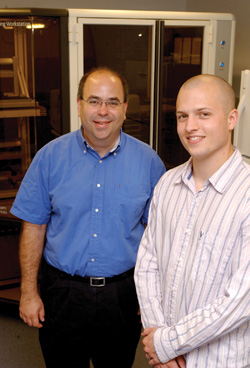
David Friedman, Ph.D., left, and Devin Stauff, graduate student, in the Vanderbilt Proteomics Laboratory.
Photo by Susan Urmy
Proteomics approach reveals how bacteria can ‘steal’ iron
We play a game of iron “keep-away” with our bacterial foes.
They need iron to successfully infect us and cause disease. We hide it inside our cells, mostly bound to heme-containing proteins like hemoglobin.
A team of Vanderbilt University Medical Center investigators is studying how bacteria “steal” iron away from its binding proteins. The mechanisms bacteria use to acquire iron could point to targets for new antibiotics, said Eric Skaar, Ph.D., assistant professor of Microbiology and Immunology.
In previous studies, Skaar and his colleagues found that Staphylococcus aureus (“staph”) “gets iron by popping open your red blood cells — during a blood-borne infection — pulling out the hemoglobin, sucking that up and eating it,” he said.
But heme-eating is a little tricky for staph: the right amount is required, but too much is toxic.
“We figured that staph must have some mechanism to monitor heme levels so that it doesn't eat too much, but eats enough to satisfy its iron requirement,” Skaar said.
To understand how staph responds to iron levels, graduate student Devin Stauff and David Friedman, Ph.D., associate director of the Vanderbilt Proteomics Laboratory, devised a strategy to examine — on a global scale — which proteins staph expresses in response to iron-rich and iron-poor conditions.
The results of their studies are reported in the current issue of PLoS Pathogens.
The investigators used a proteomics technology called DIGE/MS (Difference Gel Electrophoresis/Mass Spectrometry), which enables the quantitative examination and identification of proteins that change in abundance and post-translational modification in response to different experimental conditions, Friedman said.
In the current studies, the team examined these changes in more than 1,000 resolved staph proteins in response to environmental or genetic alterations in bacterial iron exposure. They identified 120 proteins that are affected, including several coordinated biochemical pathways.
When iron is scarce, staph coordinates a change in its central metabolism to alter the end products it pumps out, the investigators found. It produces chemicals that make the environment more acidic, which causes iron to pop off the proteins that are hiding it.
“I think the study shows exceptionally well how DIGE/MS technology can lead to new insights into the underlying mechanisms of the phenotype(s) under study,” Friedman said. “This is directly applicable to almost any experimental design, including many clinical studies.”
Friedman noted that since 2002 this technology has been applied to over 170 projects from over 70 individual laboratories at Vanderbilt ranging from basic science to cancer biology. The Proteomics Laboratory is beginning to explore larger-scale clinical studies, he said.
Staphylococcus aureus is the leading cause of skin and soft tissue infections, the leading cause of infectious heart disease, the No. 1 hospital-acquired infection, and one of four leading causes of food-borne illness, Skaar noted.
“And to top the list, staph can be resistant to just about every drug that we have,” Skaar said. Particularly troubling, he pointed out, is the increase in methicillin-resistant S. aureus (MRSA) in community-associated staph isolates. Some investigators have suggested that we are returning to a pre-penicillin-like era, when systemic staph infections had an approximately 80 percent fatality rate, Skaar said.
“We're certainly in need of novel approaches to both treatment and prevention of staph infections,” he said.
The idea of blocking the ability of bacteria to acquire nutrients, especially iron, as a way to kill them, has been around for decades, Skaar said.
“The concept is perfect: develop a way to inhibit iron acquisition or utilization, and you will prevent infection. But in practicality, this approach is very difficult.”
Other authors of the PLoS Pathogens paper (freely available at pathogens.plosjournals.org) include Gleb Pishchany, Corbin W. Whitwell and Victor J. Torres.
The research was supported by VUMC development funds, the National Institute of Allergy and Infectious Diseases, and the Vanderbilt Academic Venture Capital Fund for Proteomics.













